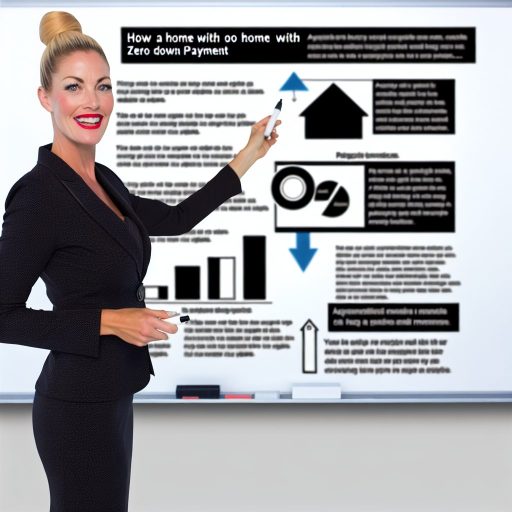Understanding Mortgage Types: Fixed vs. Adjustable Rate Mortgages
Fixed Rate Mortgages
A fixed rate mortgage offers a stable interest rate for the entire loan term.
This stability makes it easier for homeowners to budget their monthly payments.
Fixed rate mortgages are ideal for those planning to stay in their home long-term.
Additionally, they protect homeowners from interest rate fluctuations.
Most fixed rate mortgages follow a standard term of 15 to 30 years.
Adjustable Rate Mortgages
An adjustable rate mortgage has an interest rate that may change over time.
Initially, these loans typically offer lower rates than fixed mortgages.
However, the interest rate adjustments can lead to increased payments later.
Homeowners should understand the potential implications of rising rates.
ARMs often come with caps on how much rates can increase each adjustment period.
Comparative Assessment
Choosing between fixed and adjustable rate mortgages depends on individual circumstances.
Those seeking stability might prefer fixed rate mortgages for peace of mind.
Conversely, risk-tolerant individuals may favor adjustable rates for initial savings.
Homeowners should carefully evaluate their financial situation and goals.
Furthermore, consulting with a financial advisor can provide valuable insights.
Transform Your Real Estate Decisions
Unlock personalized real estate insights crafted just for you. Get actionable advice designed to amplify your success.
Get StartedLong-Term Considerations
Fixed rate mortgages generally offer predictable long-term costs.
In contrast, adjustable rate mortgages can lead to varying financial obligations.
Over the life of the loan, these differences can significantly impact affordability.
Ultimately, understanding these distinctions aids in making informed decisions.
Common Hidden Costs in Mortgages: What to Look For
Understanding Hidden Fees
Hidden fees can significantly impact your mortgage costs.
Many buyers overlook these expenses during home purchasing.
Common hidden fees include origination fees and application fees.
They can add thousands to your upfront costs.
Additionally, lenders may charge underwriting fees.
These fees cover the cost of processing your mortgage.
Neighborhood and Property-Related Costs
Property taxes often surprise new homeowners.
These taxes depend on local government rates.
They can vary significantly from one area to another.
Homeowner’s insurance is another potential hidden cost.
Showcase Your Real Estate Business
Publish your company profile on our blog for just $200. Gain instant exposure and connect with a dedicated audience of real estate professionals and enthusiasts.
Publish Your ProfileThis insurance protects against unforeseen damages.
Some areas also require flood insurance, which can be pricey.
Maintenance and Association Fees
Buying a home entails costs beyond the mortgage payment.
Home maintenance can quickly add up over time.
New owners should budget for repairs and landscaping.
If you live in a community with a homeowner’s association, fees apply.
These fees contribute to community maintenance and improvements.
Mortgage Insurance and Interest Rates
Mortgage insurance is essential for those with low down payments.
This insurance protects the lender if you default on your loan.
You might not realize its cost until the payment comes due.
Additionally, interest rates greatly affect your overall costs.
A lower rate can save you thousands in the long run.
However, adjusting your loan term can also influence interest rates.
Impact of Closing Costs on Overall Mortgage Expenses
Understanding Closing Costs
Closing costs represent essential fees during the mortgage process.
These costs typically include various expenses such as appraisals and inspections.
Understanding these costs helps borrowers plan their finances better.
Also, they affect the total cost of homeownership directly.
Components of Closing Costs
Numerous factors make up closing costs on a mortgage.
- Loan origination fees cover the lender’s processing expenses.
- Title insurance protects against potential ownership disputes.
- Appraisal fees ensure the home’s value aligns with the sale price.
- Inspections reveal any necessary repairs before purchase.
- Prepaid taxes and insurance establish initial coverage for the buyer.
Each of these costs plays a pivotal role in the closing process.
Effect of Closing Costs on Mortgage Affordability
High closing costs can strain a buyer’s budget significantly.
Buyers need to assess whether they can manage these additional expenses.
A higher overall cost may push some buyers out of the market.
Furthermore, it reduces their ability to fund home improvements or renovations.
Strategies to Manage Closing Costs
Effective strategies enable buyers to mitigate closing costs.
- Shop around for lenders to find competitive fees.
- Negotiate closing costs with the seller during the purchase process.
- Look for programs assisting first-time homebuyers with costs.
Implementing these strategies can lead to substantial savings.
Long-term Effects on Home Ownership
Closing costs influence long-term home ownership expenses considerably.
When buyers finance closing costs, they pay interest on them over time.
This addition can substantially increase the total mortgage cost.
Consequently, understanding these costs is essential for making informed decisions.
Delve into the Subject: Understanding Mortgage Insurance And Its Impact On Home Buying Decisions
Showcase Your Real Estate Business
Publish your company profile on our blog for just $200. Gain instant exposure and connect with a dedicated audience of real estate professionals and enthusiasts.
Publish Your ProfilePrivate Mortgage Insurance (PMI): When It’s Required and Its Costs
What is PMI?
Private mortgage insurance (PMI) protects lenders from default risk.
This insurance is often required when a borrower cannot make a 20% down payment.
PMI costs range from 0.3% to 1.5% of the original loan amount annually.
When is PMI Required?
PMI is typically necessary for conventional loans with low down payments.
If you finance more than 80% of the home’s value, expect to pay PMI.
Some government-backed loans do not require PMI but may have similar insurance.
How is PMI Calculated?
Lenders determine PMI based on several factors.
Your credit score is a major influence on PMI rates.
Additionally, the loan-to-value ratio impacts the cost significantly.
Monthly PMI Payments
PMI can be paid monthly or as a one-time upfront premium.
Monthly premiums are added to your mortgage payment.
Alternatively, some lenders allow a one-time payment at closing.
Effects of PMI on Home Ownership
PMI can increase your monthly mortgage payment substantially.
This extra cost impacts affordability for some homebuyers.
Ultimately, it may delay reaching equity in your home.
How to Eliminate PMI
Borrowers can eliminate PMI by reaching 20% equity in their home.
Regular payments or home appreciation can help reach this threshold.
Refinancing may also provide a path to remove PMI.
Alternatives to PMI
Some lenders offer alternatives to traditional PMI.
For example, lender-paid mortgage insurance (LPMI) may be available.
This option often results in a higher interest rate instead of monthly PMI payments.
Learn More: Understanding The Comprehensive Home Inspection Checklist Before Buying
Property Taxes: Calculating Your Annual Costs and Their Impact on Affordability
Understanding Property Taxes
Property taxes are a significant aspect of home ownership.
These taxes vary by location and can dramatically affect affordability.
They are typically based on the assessed value of your property.
Understanding how property taxes are determined is essential for homeowners.
Many local governments calculate property taxes annually.
These calculations consider various factors that can change over time.
Calculating Your Annual Property Tax Costs
To calculate your annual property tax costs, follow a few steps.
First, find the assessed value of your property.
Showcase Your Real Estate Business
Publish your company profile on our blog for just $200. Gain instant exposure and connect with a dedicated audience of real estate professionals and enthusiasts.
Publish Your ProfileThis value is often available on your local tax assessor’s website.
Next, identify the tax rate for your locality.
Tax rates can vary greatly between communities.
Once you have both figures, use the formula:
Property Tax = Assessed Value x Tax Rate.
This will give you your annual property tax bill.
Understanding the Impact on Affordability
High property taxes can significantly impact your monthly budget.
Increased taxes may require higher monthly mortgage payments.
For many new homeowners, this can strain finances.
It’s essential to factor property taxes into your overall home-buying budget.
Budgeting for Property Taxes
When creating a budget, don’t overlook property taxes.
Include property taxes in your monthly expenses alongside mortgage payments.
This will provide a clearer picture of your financial commitment.
In addition, consider setting aside funds for potential tax increases.
Property taxes can fluctuate based on local economic conditions.
By preparing for these increases, you can maintain financial stability.
Exploring Exemptions and Deductions
Some homeowners might qualify for property tax exemptions or deductions.
Research any available programs in your area.
For instance, some states offer exemptions for first-time buyers.
Others may have programs for veterans or senior citizens.
Applying for these can lead to significant savings.
The Consequences of Unpaid Property Taxes
Failing to pay property taxes can result in dire consequences.
Local governments may place liens on properties over unpaid taxes.
In extreme cases, homes can be foreclosed upon.
It’s vital to stay current on your property tax payments.
Establishing a monthly savings plan can help avoid these issues.
Gain More Insights: Home Inspection Checklist For Verifying Appliance Functionality In Homes

The Role of Homeowner’s Insurance in Mortgage Payments
Understanding Homeowner’s Insurance
Homeowner’s insurance protects your home and belongings from damage or theft.
This insurance covers several potential risks homeowners face.
Typically, it includes coverage for fire, vandalism, and natural disasters.
Showcase Your Real Estate Business
Publish your company profile on our blog for just $200. Gain instant exposure and connect with a dedicated audience of real estate professionals and enthusiasts.
Publish Your ProfileAdditionally, it often covers liability for accidents that occur on your property.
Importance in Mortgage Payments
Homeowner’s insurance affects your overall mortgage payment significantly.
Lenders require this insurance to protect their investment in your home.
As a result, the cost of insurance is usually included in your monthly mortgage payment.
This ensures homeowners maintain continuous coverage throughout the loan period.
Calculating Insurance Costs
Understanding how insurance costs are calculated is crucial for budgeting.
Insurance premiums vary based on several factors.
- The value and location of the home.
- Your credit score and claims history.
- The amount of coverage you choose to purchase.
It’s advisable to shop around for the best rates before finalizing your mortgage.
Effects of Insurance Premium Increases
Insurance premiums can rise due to various reasons.
Increases in natural disasters often drive up insurance costs in certain areas.
These rising costs can strain your monthly budget.
Homeowners should anticipate potential increases and plan accordingly.
Tips for Managing Homeowner’s Insurance
There are several strategies to manage homeowner’s insurance effectively.
- Increase your deductible to lower your premium.
- Bundle your insurance policies for potential discounts.
- Regularly review your coverage needs and costs.
Keeping these strategies in mind helps homeowners maintain affordability.
See Related Content: Key Factors For A Thorough Home Inspection Checklist To Protect Buyers
Maintenance and Repair Costs: Planning for the Unexpected
Understanding Hidden Costs
Home ownership brings various unexpected expenses.
Maintenance and repair costs can quickly add up over time.
These costs often catch new homeowners by surprise.
Proper planning is essential for financial stability.
Common Maintenance Expenses
Homeowners face several routine maintenance expenses.
These include lawn care, gutter cleaning, and HVAC servicing.
Regular upkeep prevents larger issues from developing later.
Neglecting these tasks can lead to costly repairs.
Unexpected Repairs
Unexpected repairs can significantly impact budgets.
Examples include plumbing issues, roof leaks, and electrical problems.
Having an emergency fund can alleviate financial strain.
Homeowners should anticipate these potential repairs.
Estimating Annual Maintenance Costs
Estimating annual maintenance costs is crucial for planning.
A common guideline is to set aside 1% to 2% of the home’s value.
This fund helps cover unexpected repairs effectively.
Showcase Your Real Estate Business
Publish your company profile on our blog for just $200. Gain instant exposure and connect with a dedicated audience of real estate professionals and enthusiasts.
Publish Your ProfileRegular assessments of the home can aid in budgeting accurately.
Professional Help vs. DIY
Some homeowners choose to tackle repairs themselves.
DIY can save money but requires skill and time.
Hiring professionals ensures quality but increases costs.
Evaluating the situation helps determine the best approach.
Future Planning for Maintenance Costs
Planning for maintenance and repair costs is a vital part of home ownership.
Anticipating both routine and unexpected expenses keeps finances stable.
By budgeting effectively, homeowners can protect their investment.
Proper planning allows for a stress-free home ownership experience.
Effect of Interest Rate Changes on Long-Term Mortgage Costs
Understanding Interest Rate Changes
Interest rates play a crucial role in mortgage affordability.
They directly influence monthly payments for homeowners.
As rates increase, so do the overall costs of mortgages.
This occurs because interest is a significant component of loan payments.
Consequently, higher rates lead to larger financial burdens.
Implications for Home Buyers
Homebuyers face increased monthly costs due to higher interest rates.
This change can limit their purchasing power.
Many potential buyers may need to adjust their home search criteria.
Furthermore, it can lead to longer loan terms as buyers seek lower payments.
Increased rates may also discourage first-time buyers.
Effects on Total Loan Costs
Long-term mortgage costs can escalate significantly with rising rates.
A small increase can result in thousands of dollars over 30 years.
For example, a 1% rate increase can add about $50,000 to a typical mortgage.
This scenario highlights the importance of locking in lower rates.
Homeowners should carefully evaluate their financing options.
Market Dynamics and Social Impact
Shifts in interest rates can affect the broader housing market.
Increased rates may lead to slower home sales and reduced market activity.
This slowdown can harm sellers in a high-rate environment.
Moreover, it may promote a rental market surge.
People might opt for renting due to higher borrowing costs.
Considerations for Homeowners
Homeowners must stay informed about interest rate trends.
Showcase Your Real Estate Business
Publish your company profile on our blog for just $200. Gain instant exposure and connect with a dedicated audience of real estate professionals and enthusiasts.
Publish Your ProfileBy doing so, they can make better mortgage decisions.
Understanding these dynamics ensures effective long-term financial planning.
Being proactive can mitigate the adverse effects of rising rates.
Ultimately, proper planning leads to sustainable home ownership.
Additional Resources
Buying A Home With A VA-Backed Loan | Veterans Affairs
What should every new homeowner know before buying their first …




